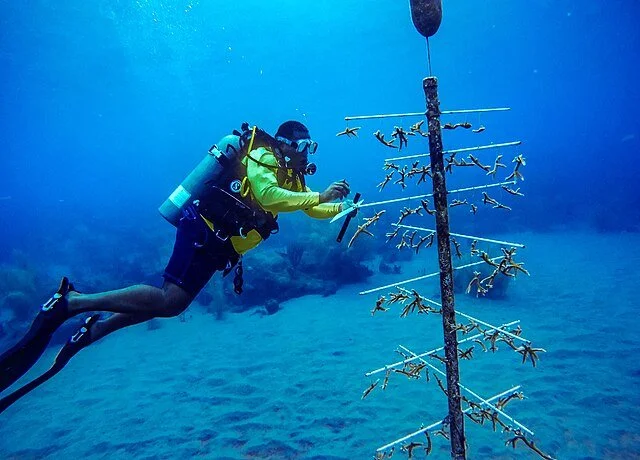A group of environmentalists based out of the Florida Keys have devised a way to farm coral and help rebuild dead reefs.
One of the Coral Restoration Foundation’s Coral Trees. UVI, CC BY 2.0
Coral reefs are one of the biggest hubs for natural diversity in the world. Hundreds of thousands of unique species make their homes in or around these lush underwater sanctuaries all across the globe. The reefs themselves even serve a variety of purposes; they can protect coastlines from destructive waves, provide millions of dollars worth of food, and billions more through tourism.
However, global warming, ocean acidification, and pollution runoff have led to a drastic decrease in the amount of living coral left in the world. Reports show that over 50% of all coral on Earth has been killed, and a projected 90% may be dead by the end of the century.
The Florida Reef, the only true “barrier” reef in the United States, has lost around 90% of all corals since the 1980s. Recent heat waves have devastated the remaining population; scientists are still trying to assess the damage after the record high water temperatures of the summer of 2023.
But despite the damage that has been done, there are still ways to salvage the reefs. One particular nonprofit organization, founded in 2007 in response to the growing crisis, has been fighting to replenish various coral species around the Florida Keys in a rather unique way. The Coral Restoration Foundation has made immense progress both researching and redeveloping reefs through a process known as “coral outplanting”, which essentially amounts to underwater farming.
Coral can reproduce in two different ways. The first way involves releasing and fertilizing larvae in the open water, a feat that can only be accomplished by certain species. The other, far more common method is known as “budding” or “fragmentation,” depending on whether it involves an individual polyp or a whole colony. This process works in much the same way as a starfish or a worm regenerates itself; a piece of coral branches off from the main colony and eventually physically breaks away. That piece then latches onto the seafloor and develops over time into an entirely new colony, spreading the reef further.
Groups such as the Coral Restoration Foundation use fragmentation in order to construct their farms. Small pieces of viable coral growths are taken and hung from PVC “coral trees,” which are tethered to the seafloor and held up by a buoy. The fragments are hung from the tree’s “branches” with plenty of space to grow; once they’ve become big enough to survive on their own, divers will remove the sample from the trees for replanting.
The “outplanting” process begins with the coral colonies being taken to selected locations and directly cemented to the reef with a marine epoxy. Ideally, these corals will then start to grow and develop on their own, fragmenting and budding into more and more colonies until a full reef has been created.
According to the Foundation’s own reports, over 220,000 individual corals have been replanted in the Keys, with more than 34,000 square meters having been replenished. What’s more, the farms themselves have started acting as makeshift reefs of their own; reef fish and other organisms are often found in or around the trees, feeding and mating in much the same way they would on a normal reef.
Although the replanted reefs are still susceptible to bleaching and other dangers, the Coral Restoration Foundation’s efforts have resulted in an unprecedented level of reef recovery. They have begun to see coral on their “artificial” reefs actually beginning to spawn naturally, meaning that the reefs are well on their way to recovering on their own. The first recorded natural spawning of replanted coral was documented in 2009, and ever since the Coral Restoration Foundation has worked tirelessly to spread this effect across the Florida Reef. Someday, the entire barrier reef may be back to its full beauty and health thanks to this and similar organizations.
How to Get Involved
The Coral Restoration Foundation provides a variety of ways to help out, from education and events to volunteering and even hands-on scuba and snorkeling programs. Interested parties can sign up on the organization’s website, and educational programs can be accessed here. You can also sign up for their newsletter, the Coral Chronicles, on their homepage.
Ryan Livingston
Ryan is a senior at The College of New Jersey, majoring in English and minoring in marketing. Since a young age, Ryan has been passionate about human rights and environmental action and uses his writing to educate wherever he can. He hopes to pursue a career in professional writing and spread his message even further.


